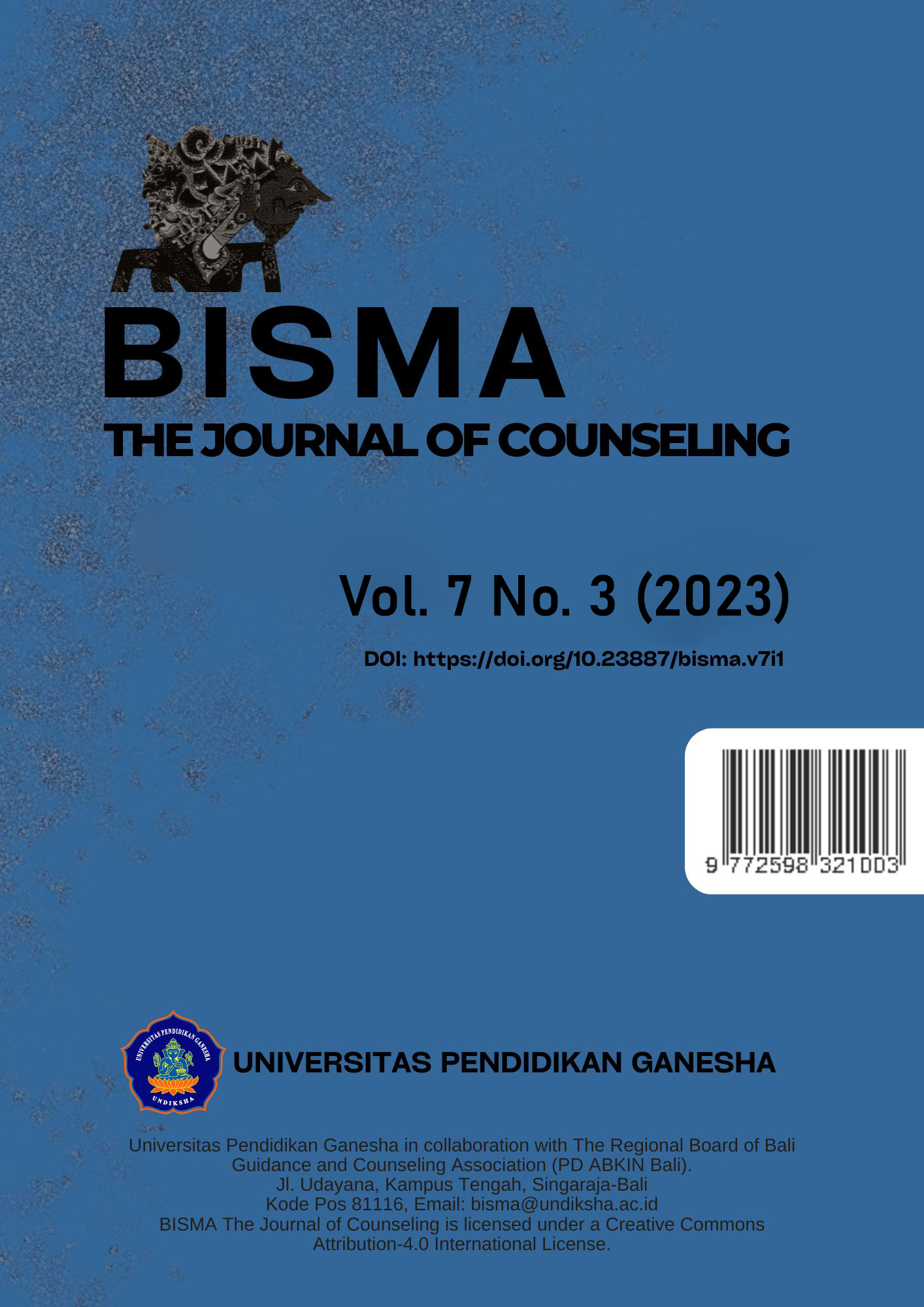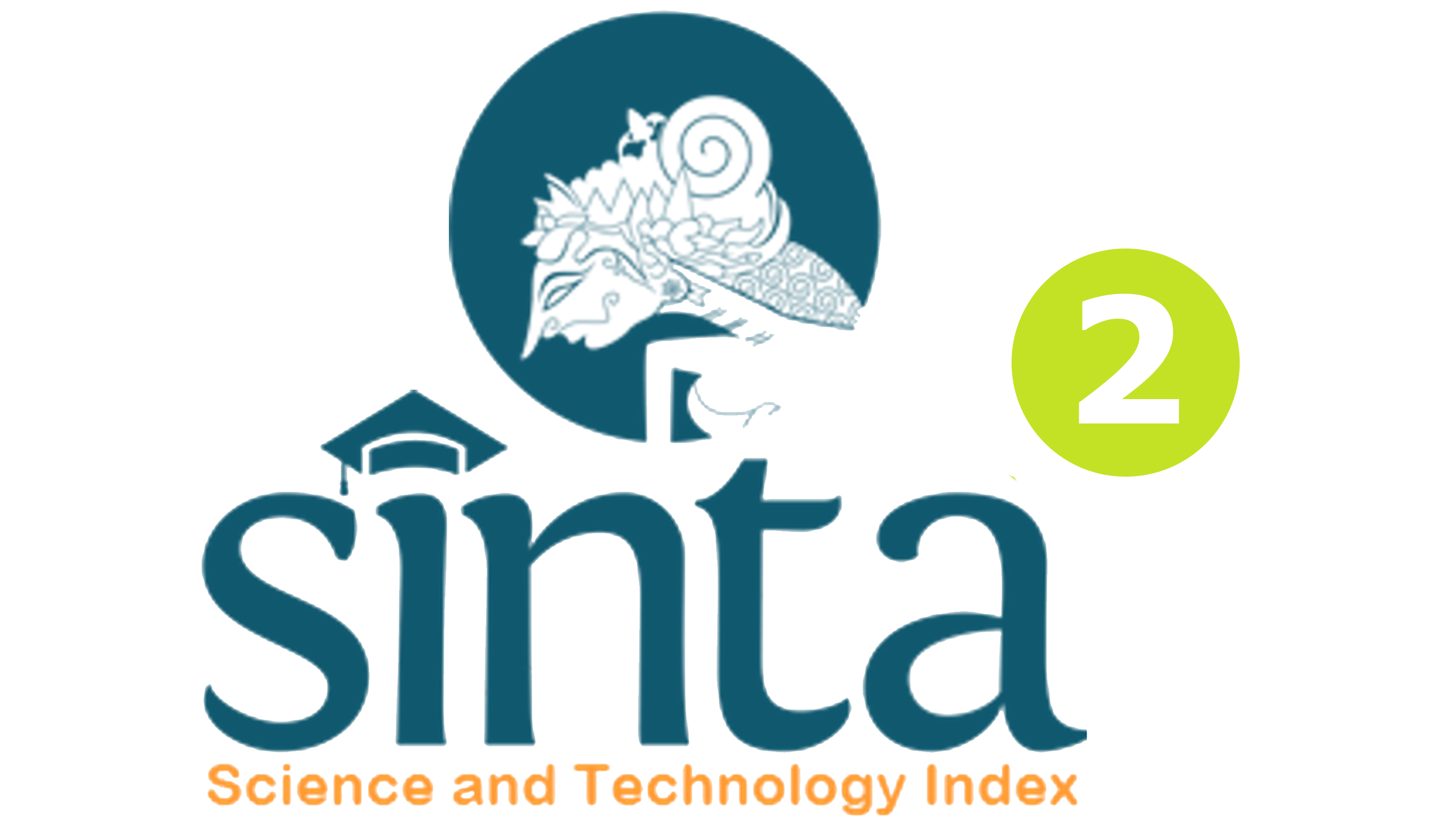Religious Self Report in the Use of Social Media: Improved Counseling Guidance Services
DOI:
https://doi.org/10.23887/bisma.v7i3.69319Keywords:
Religious, Self Report, Social Media, Self Control, Confirmatory Factor AnalysisAbstract
Social media has become the most popular platform in recent years. The high level of access and easy access to various content allows teenagers to use social media excessively and unwisely, so it is necessary to instill religious values in teenagers as natural self-control. Efforts to instill religious values need to be assisted by instruments that are able to measure the religious level of adolescents so that educational designers such as guidance and counseling teachers and Islamic religious education teachers can plan appropriate materials and types of services. The aim of this study is to develop an instrument in the form of a self-report with a Likert Scale model and is non-test in nature. This study uses an R&D approach through the 10 stages of the Borg & Gall development model. Participants numbered 509 teenagers of junior high school age, who were taken using random samples. The reliability test has been carried out using the Alpha Cronbach formula and to see the validity and level of match between items and indicators, Confirmatory Factor Analysis has been used through the Structural Equating Modeling application. The indicators that have been used to measure the religious level of teenagers are Faith, Islam, and Ihsan according to the Muslim History Hadith. The results of the analysis have shown that 30 items are valid, fit and reliable and have fulfilled the practical objectives of preparing the instrument, namely that it can be done in a short time and is easy to do without help from other parties.
References
Albet Maydiantoro. (2019). Model-Model Penelitian Pengembangan (Research and Development). Jurnal Metode Penelitian, 10, 1–8. http://repository.lppm.unila.ac.id/34333/1/Model-Model Penelitian dan Pengembangan.pdf.
Ali AL-gasem, A. (2019). Impact of Social Media on the Mental Health of Teenagers in the Us. Journal of University Studies for Inclusive Research, 1(1), 200–217. https://doi.org/10.14421/mjsi.72.2936.
Anugrah, R. L., Asrin, A., Musa, F., Tanjung, A., Pendidikan, F., & Islam, A. (2019). 2019 Islam Islam Dan Ihsan Dalam Kitab Matan. Tarbiyah: Jurnal Ilmiah Pendidikan Agama Islam, 9(2), 29–44. http://www.conferences.uinsgd.ac.id/index.php/gdcs/article/view/1536.
Azizah, Z., Taqwa, M. R., & Assalam, I. T. (2020). Analisis Pemahaman Konsep Fisika Peserta Didik Menggunakan Instrumen Berbantukan Quizziz. Jurnal Pendidikan Sains & Matematika, 8(2), 1–11. https://doi.org/10.23971/eds.v8i2.1707.
Boer, M., van den Eijnden, R. J. J. M., Boniel-Nissim, M., Wong, S. L., Inchley, J. C., Badura, P., Craig, W. M., Gobina, I., Kleszczewska, D., Klanšček, H. J., & Stevens, G. W. J. M. (2020). Adolescents’ Intense and Problematic Social Media Use and Their Well-Being in 29 Countries. Journal of Adolescent Health, 66(6), S89–S99. https://doi.org/10.1016/j.jadohealth.2020.02.014.
Brandmo, C., Aas, M., Colbjørnsen, T., & Olsen, R. (2021). Group Coaching that Promotes Self-Efficacy and Role Clarity among School Leaders. Scandinavian Journal of Educational Research, 65(2), 195–211. https://doi.org/10.1080/00313831.2019.1659406.
Carmel, T., & Widom, C. S. (2020). Development and validation of a retrospective self-report measure of childhood neglect. Child Abuse and Neglect, 106(May), 104555. https://doi.org/10.1016/j.chiabu.2020.104555.
Chu, Y. H., & Li, Y. C. (2022). The Impact of Online Learning on Physical and Mental Health in University Students during the COVID-19 Pandemic. International Journal of Environmental Research and Public Health, 19(5). https://doi.org/10.3390/ijerph19052966.
Erfani, H. (2019). Research and Development. In LAP Lambert. LAP Lambret Academy Publishing. https://doi.org/10.12968/npre.2007.5.5.23745.
Gerda, M. M. (2023). Comparison of curriculum strategies for the prevention of child sexual abuse (CSA) in developing and developed countries. Jurnal Obsesi : Jurnal Pendidikan Anak Usia Dini, 7(5), 5380–5396. https://doi.org/10.31004/obsesi.v7i5.5323.
Gu, Y. (2018). Narrative, life writing, and healing: the therapeutic functions of storytelling. Neohelicon, 45(2), 479–489. https://doi.org/10.1007/s11059-018-0459-4.
Gunawan, A. R., & Amalia, R. (2020). Peran Guru PAI dalam Bimbingan Konseling Siswa Bermasalah di SMA 1 Tambun Utara Kabupaten Bekasi. Eduprof : Islamic Education Journal, 2(2), 32–47. https://doi.org/10.47453/eduprof.v4i1.112.
Hartina, A. W. (2022). Impact of Problem Based Learning For Increase Skills Collaboration in Learning thematic. Journal of Education Action Research, 6(3), 341–347. https://doi.org/10.23887/jear.v6i3.
Hettinger, K., Lazarides, R., Rubach, C., & Schiefele, U. (2021). Teacher classroom management self-efficacy: Longitudinal relations to perceived teaching behaviors and student enjoyment. Teaching and Teacher Education, 103, 103349. https://doi.org/10.1016/j.tate.2021.103349.
Jasmi, K. A. (2018). Ciri Orang Yang Bertakwa : Surah Al-Baqarah ( 2 : 1-5 ). Jasmi, Kamarul Azmi (2018). “Ciri Orang Yang Bertakwa: Surah Al-Baqarah (2: 1-5)” in Program Budaya Al-Quran Pada 26hb. Julai 2018 Di Kolej Tun Fatimah, UTM. Program Anjuran Pusat Is- Lam, UTM, p. 1-28., July, 1–5.
Joshi, A., Kale, S., Chandel, S., & Pal, D. (2015). Likert Scale: Explored and Explained. British Journal of Applied Science & Technology, 7(4), 396–403. https://doi.org/10.9734/bjast/2015/14975.
Kadafi, A., Suharni, Mahmudi, I., & Pratama, B. D. (2020). Urgency Strengthening Religious Values in Guidance and Counseling Programs in the New Normal Era. 1st International Conference On Information Technology And Education (ICITE 2020) Urgency, 508(Icite), 285–290. https://doi.org/10.2991/assehr.k.201214.250.
Kalton, G. (2022). Simple Random Sampling. Introduction to Survey Sampling, December, 9–16. https://doi.org/10.4135/9781412984683.n2.
Kercher, K. A., Steinfeldt, J. A., Rettke, D. J., Zuidema, T. R., Walker, M. J., Martinez Kercher, V. M., Silveyra, P., Seo, D.-C., Macy, J. T., Hulvershorn, L. A., & Kawata, K. (2023). Association Between Head Impact Exposure, Psychological Needs, and Indicators of Mental Health Among U.S. High School Tackle Football Players. Journal of Adolescent Health, 72(4), 502–509. https://doi.org/10.1016/j.jadohealth.2022.11.247.
Keyton, J. (2020). Collaboration. In The International Encyclopedia of Organizational Communication. (Issue March 2017). John Wiley & Sons, Inc. https://doi.org/10.1002/9781118955567.wbieoc026.
Kjeldsen, K. (2019). A study-of-religion(S)-based religion education: Skills, knowledge, and aims. Center for Educational Policy Studies Journal, 9(4), 11–29. https://doi.org/10.26529/cepsj.678.
Lestari, P., Sugiyo, S., & Purwanto, E. (2022). The effectiveness of reality group counseling to improve students ’. Jurnal Bimbingan Konseling, 11(2), 82–86. https://doi.org/10.15294/JUBK.V11I2.57327.
Mairoza, A., & Silvianetri, S. (2023). Religious Cultural Approach Group Counseling. Jurnal Neo Konseling, 5(2), 54. https://doi.org/10.24036/00684kons2023.
Masmuzidin, M. Z., Jiang, J., & Wan, T. (2022). Learning moral values through virtual technology: The development and evaluation of Malaysian virtual folktales-Hikayat Land. Procedia - Social and Behavioral Sciences, 31(2011), 315–322. https://doi.org/10.1016/j.sbspro.2011.12.061.
Mite Setiansah, Nuryanti, Toto Sugito, S. Bekti Istiyanto, Shinta Prastyanti, & Chusmeru. (2022). Adolescent Information and Counseling Center in the Digital Age: Changing or Going Extinct [The Existence of PIK-Remaja at SMA IT Al Irsyad Purwokerto]. Proceedings Of International Conference On Communication Science, 2(1), 694–703. https://doi.org/10.29303/iccsproceeding.v2i1.65.
Muhdi, Nurkolis, & Yuliejantiningsih, Y. (2020). The Implementation of Online Learning in Early Childhood Education During the Covid-19 Pandemic. JPUD - Jurnal Pendidikan Usia Dini, 14(2), 247–261. https://doi.org/10.21009/jpud.142.04.
Nafi, A. A. (2021). Pengaruh kecerdasan spiritual terhadap kontrol diri siswa. Angewandte Chemie International Edition, 6(11), 951–952., 1(1), 41–46. https://eprints.walisongo.ac.id/21936/1/Skripsi_1908026003_Alvania_Nabila_Tasyakuranti.pdf.
Nasution, H. A., & Suyadi, S. (2020). Pembelajaran Pendidikan Agama Islam Humanistik dengan Pendekatan Active Learning di SDN Nugopuro Gowok. Jurnal Pendidikan Agama Islam, 17(1), 31–42. https://doi.org/10.14421/jpai.2020.171-03.
Noori, N., Sayes, A., & Anwari, G. (2023). The Negative Impact of Social Media on Youth’s Social Lives. International Journal Of Humanities Education and Social Sciences (IJHESS), 3(1), 481–493. https://doi.org/10.55227/ijhess.v3i1.613.
Nuñez-Rola, C., & Ruta-Canayong, N. J. (2019). Social Media Influences to Teenagers. International Journal of Research Science & Management, 6(6), 38–48. https://doi.org/10.5281/zenodo.3260717.
Nye, C. D. (2022). Reviewer Resources: Confirmatory Factor Analysis. In Organizational Research Methods (Vol. 26, Issue 4). https://doi.org/10.1177/10944281221120541.
Prayitno, Afdal, Ifdil, Z. A. (2017). Bimbingan Kelompok & Konseling Kelompok yang Berhasil (1st ed.). Ghalia Indonesia.
Quainoo, E. A., Bortey, J., Brew, E. A., & Pinamang, I. (2022). Testing and assessment in counselling. International Journal of Educational Innovation and Research, 1(2), 128–134. https://doi.org/10.31949/ijeir.v1i2.2505.
Rahima, R., & Herlinda, F. (2017). Instrumen Bk 1 (A. Diniaty (ed.)). Cahaya Firdaus.
Ritchey, K., Olney, A., Chen, S., & Phelan, E. A. (2022). STEADI Self-Report Measures Independently Predict Fall Risk. Gerontology and Geriatric Medicine, 8, 1–6. https://doi.org/10.1177/23337214221079222.
Saleem, R. M. A. (2019). Religious Values and Worldviews. Oxford Research Encyclopedia of Politics, August, 1–25. https://doi.org/10.1093/acrefore/9780190228637.013.1158.
Silviana, I. (2021). Religiusitas Sebagai Modal Sosial Mahasiswa E-Preneur Prodi Sosiologi Agama Iain Kediri. Jurnal Sosiologi Reflektif, 15(2), 380. https://doi.org/10.14421/jsr.v15i2.2130.
Subur, Aji, S. P., Somadayo, S., & Kurniawan, H. (2022). Development of Literacy Programs for Students in School Libraries in Indonesia. Jurnal Kependidikan: Jurnal Hasil Penelitian Dan Kajian Kepustakaan Di Bidang Pendidikan, Pengajaran Dan Pembelajaran, 8(2), 460–469. https://doi.org/10.33394/jk.v8i2.5163.
Sutton, A., & Crobach, C. (2022). Improving self-awareness and engagement through group coaching. International Journal of Evidence Based Coaching and Mentoring, 20(1), 35–49. https://doi.org/10.24384/dqtf-9x16.
Valverde-Espinoza, N., Barja-Ore, J., Rojas, M. S., Pérez-Silva, M., Herrera-Málaga, R., Angulo, L. H., & López, B. R. (2023). Personal protective equipment: Analysis of supply among midwives during the COVID-19 pandemic in Peru. Midwifery, 118, 103583. https://doi.org/10.1016/j.midw.2022.103583.
Vasanth, R., & Swamy, S. (2013). Social media’s impact on teenagers. Lecture Notes in Computer Science (Including Subseries Lecture Notes in Artificial Intelligence and Lecture Notes in Bioinformatics), 8023(PART 1), 477–485. https://doi.org/10.1007/978-3-642-39143-9_53.
Wahidin. (2022). Dinamika Perkembangan Konseling Religius. Indonesian Journal of Guidance and Counseling : Theory and Application, 3(4), 39–46. https://repository.penerbiteureka.com/publications/563320/bunga-rampai-model-pemberdayaan-berbasis-tradisi.
Warsiyah, W. (2018). Pembentuk Religiusitas Remaja Muslim (Tinjauan Deskriptif Analitis). Cendekia: Jurnal Kependidikan Dan Kemasyarakatan, 16(1), 19. https://doi.org/10.21154/cendekia.v16i1.1262.
Widiatmoko, S. A., Pek, K., Iman, F. E. N., Annisa, A. T. R., Wulandari, F., Gupita, O. N., & Rusdi, A. (2021). Islamic Tolerance in World 4.0: Membentuk Kepribadian Toleran dan Hubungannya dengan Self-Control dalam Bersosial Media. Jurnal Abdimas Madani Dan Lestari (JAMALI), 3(1), 32–39. https://doi.org/10.20885/jamali.vol3.iss1.art5.
Williams, M. K., Foulger, T. S., & Wetzel, K. (2009). Preparing Preservice Teachers for 21st Century Classrooms: Transforming Attitudes and Behaviors About Innovative Technology. Journal of Technology and Teacher Education, 17(3), 393–418. https://www.learntechlib.org/primary/p/28216/.
Young, T., Hazarika, D., Poria, S., & Cambria, E. (2018). Recent trends in deep learning based natural language processing. Ieee Computational IntelligenCe Magazine, 13(3), 55–75. https://doi.org/10.1109/MCI.2018.2840738.
Downloads
Published
Issue
Section
License
Copyright (c) 2023 Raja Rahima Munawarah Raja Ahmad, Rahmatul Aufa, Irawati Irawati, Nurul Zahrotunnisa, Hasgimianti Hasgimianti

This work is licensed under a Creative Commons Attribution 4.0 International License.









